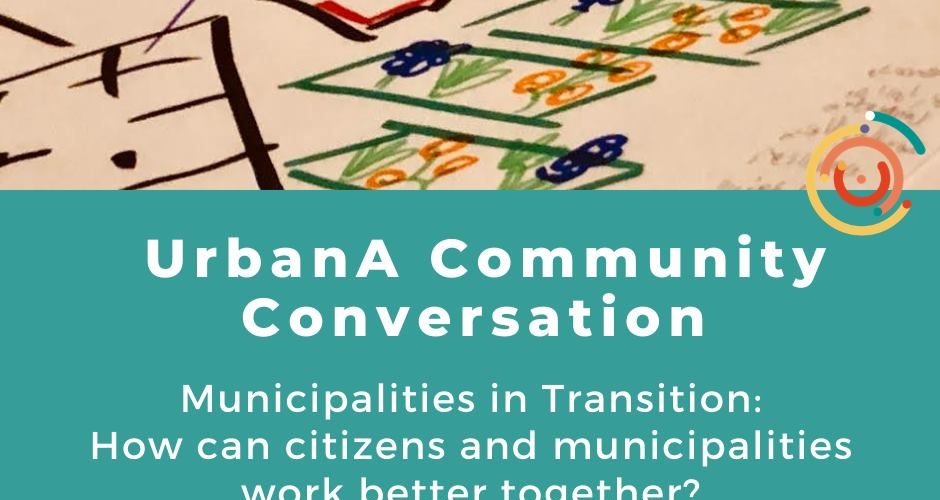
The latest UrbanA CoCo (Community Conversation online)
this blog has been adapted by a blog written for UrbanA. Check the original article here
On the 29th of September, about 60 people connected for another inspiring Community Conversation. This time it was about Municipalities in Transition (MiT), part of the larger Transition Network Movement. This was also the last “European Day of Sustainable Communities” event and it celebrated its part of the “Communities For Future” (CfF) launch by playing the CfF video, made by the ECOLISE team. Like every Community Conversation, it started with a 20 minutes presentation by Cristiano Bottone, who presented what Municipalities in Transition is all about.
Municipalities in Transition supports citizens and municipalities to better connect, learn from each other and work together to create more just and sustainable cities, villages and towns. MiT developed a system to do so, with the following features:
- Linked to Transition principles (Head-Heart-Hands)
- Both implementable top-down and bottom-up
- Deals with high complexity…
- …but easy to learn and use
- Few resources needed to implement it
- Adaptable to different contexts
- Proved to be effective
- Suitable for shared governance
- It improves cooperation among actors
- It will evolve in the future through iteration
Cristiano explained the great relevance of the last point:
We don’t want to create something that is going to stay in the community forever. Our idea is to have this system as a way to teach municipalities to face our challenges to live a better life in the community. It’s like the little wheels in the bicycle. When you feel safe enough you can remove them and run free.
If you want to delve deeper into the MiT system and Cristiano’s presentation, the recording is now available on Youtube and the slides are accessible here.
As in every CoCo, UrbanA community members had the opportunity to discuss the expert presentation and share their opinions on the subject in the breakout rooms. For the fourth time in a CoCo, a “listening room” was also created, where more time is given to the guest project. The participants in the breakout rooms were asked to respond to the following questions:
- What really prevents us from making effective decisions in communities?
- How do you feel the Municipalities in Transition methodology could be received by local administrations?
- How polarization, fake news and social media are conditioning our decisions about the future?
Some participants expressed how citizens need more space and time to interact with the municipality. Cities should be giving the responsibility to citizens to co-create a more sustainable future, together. An UrbanA community member said:
Do we, as citizens, feel the responsibility to actually make decisions? Do we feel empowered to co-create our living space and take ownership? In order to achieve this, we need more open spaces for citizens to participate in. Being there, in a space in the neighbourhood, with all its diversity and join-in. We have to reach out to where people actually are and then offer activities that are diverse also, brainstorms, theatre, dialogues, knowledge and learning.
As often happens, participants had many questions for the CoCo presenters, and not enough time to answer all of them! We asked Cristano and his colleague Tommaso Brazzini (who also joined the CoCo) to answer them after the presentation, and here they are!
Questions from the UrbanA Community for Municipalities in Transition
- Is MiT originating from the North?
MiT originated from within the Transition Hubs groups, which is in many different countries of the world, mainly in Europe and North and South America. The seminal concept comes from a framework already in use in Italy.
- Which municipalities/communities are participating today (e.g. in the Global South)?
Villa Mariana in São Paulo is the only Pioneer at the moment below the equator.
- Is the system well applicable to rural, poorer communities too?
We never experimented in those conditions so far, but in theory yes.
- Can municipalities (e.g. in Latin America) municipal grants be replaced by some other public funds?
Of courses, public, private, whatever …
- Sociocracy tool: Is too different/ too difficult to introduce as a new way of working within municipalities/administrations? How is your experience in practice?
Not so difficult if you create an “experimental space” for it, then it will probably start contaminating the surroundings … MiT is presented as a special space with special rules.
- What is the grid used for: only diagnosis?
Regarding The grid, as we already pointed out, municipalities, activists and all the actors of a community have to face the complexity of their local system day by day. Like in a boardgame, the first element of the MiTS is designed to provide a clearer, more systemic view of the “playing field”.
The Grid performs three specific functions:
-
- Defines Actors and Actions Categories
- Shows Relational Proximity between the actors
- Act as an organizer of Actions and Tools
The Grid and all the other elements of the system are used to perform the following functions (you can find more details in the framework document):
- The Evaluation and Diagnosis Function
- The Co-Design Function
- The Co-Implementation Function
- The ToolBox Function
- Cultural Leverage Function
- The Governance Innovation Function

Follow the MiT on Facebook, Twitter, Youtube and check the events of the MiT community of practice
Want to get in touch with the UrbanA Community?
Check out our upcoming events and join our dedicated chat on the Communities for Future platform or simply send an email to info@urban-arena.eu. You can also subscribe to our newsletter and follow us on Twitter, Instagram, Facebook, LinkedIn and Youtube. There’s also our podcast series.
Leave a comment